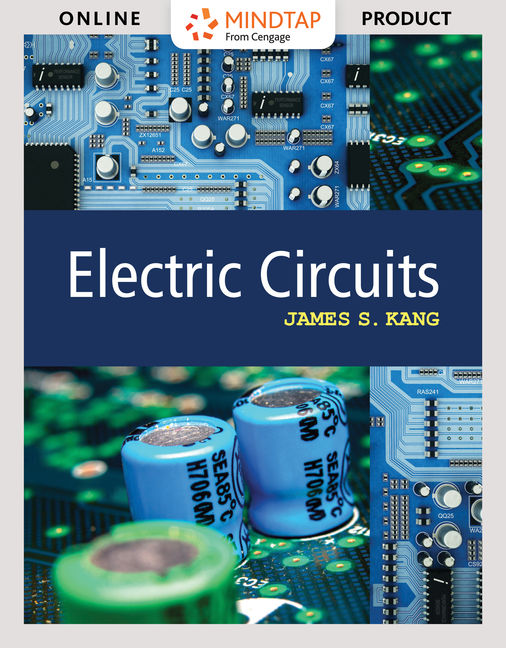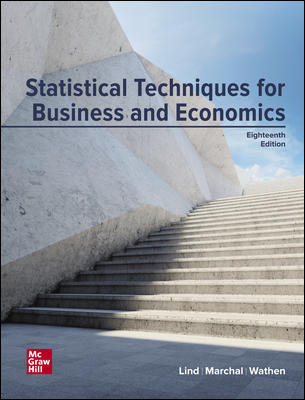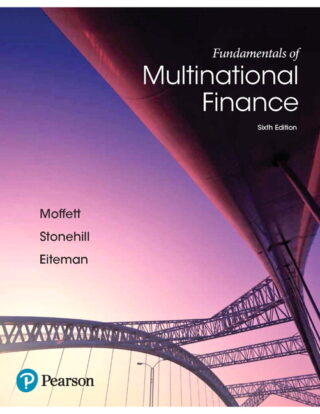Solution Manual (Downloadable Files) for Electric Circuits, 1st Edition By Dr. James S. Kang
原价为:$59.99。$15.99当前价格为:$15.99。
ISBN-10: 130563795X, ISBN-13: 9781305637955
TABLE OF CONTENTS
1. VOLTAGE, CURRENT, POWER, AND SOURCES.
Introduction. International System of Units. Charge, Voltage, Current, and Power. Independent Sources. Dependent Sources. Elementary Signals. Summary. Problems.
2. CIRCUIT LAWS.
Introduction. Circuit. Resistor. Ohm??s Law. Kirchoff??s Current Law (KCL). Kirchoff??s Voltage Law (KVL). Series and Parallel Connection of Resistors. Voltage Divider Rule. Current Divider Rule. Delta-Wye Transformation and Wye-Delta Transformation. PSpice and Simulink. Summary. Problems.
3. CIRCUIT ANALYSIS METHODS.
Introduction. Nodal Analysis. Supernode. Mesh Analysis. Supermesh. PSpice and Simulink. Summary. Problems.
4. CIRCUIT THEOREMS.
Introduction. Superposition Principle. Source Transformations. Th??venin??s Theorem. Norton??s Theorem. Norton??s Theorem. PSpice and Simulink. Summary. Problems.
5. OPERATIONAL AMPLIFIER CIRCUITS.
Introduction. Ideal Op Amp. Sum and Difference. Instrumentation Amplifier. Current Amplifier. Analysis of Inverting Configuration. Analysis of Noninverting Configuration. PSpice and Simulink. Summary. Problems.
6. CAPACITORS AND INDUCTORS.
Introduction. Capacitors. Series and Parallel Connection of Capacitors. Op Amp Integrator and Op Amp Differentiator. Inductors. Series and Parallel Connection of Inductors. PSpice and Simulink. Summary. Problems.
7. RL AND RC CIRCUITS.
Introduction. Natural Response of RC Circuit. Step Response of RC Circuit. Natural Response of RL Circuit. Step Response of RL Circuit. Solving General First-Order Differential Equations. PSpice and Simulink. Summary. Problems.
8. RLC CIRCUITS.
Introduction. Zero Input Response of Second Order Differential Equations. Zero Input Response of Series RLC Circuit. Zero Input Response of Parallel RLC Circuit. Solution of the Second-Order Differential Equations to Constant Input. Step Response of Series RLC Circuit. Step Response of Parallel RLC Circuit. General Second Order Circuits. PSpice and Simulink. Summary. Problems.
9. PHASORS AND IMPEDANCES.
Introduction. Sinusoidal Signals. RMS Value. Phasors. Impedance and Admittance. Phasor Transformed Circuit. Kirchoff??s Current Law and Kirchoff??s Voltage Law for Phasors. Series and Parallel Connection of Impedances. Delta-Wye (?-Y) and Wye-Delta (Y-?) Transformation. PSpice and Simulink. Summary. Problems.
10. ANALYSIS OF PHASOR TRANSFORMED CIRCUITS.
Introduction. Phasor Transformed Circuits. Voltage Divider Rule. Current Divider Rule. Nodal Analysis. Mesh Analysis. Superposition Principle. Source Transformation. Th??venin Equivalent Circuit. Norton Equivalent Circuit. Transfer Function. PSpice and Simulink. Summary. Problems.
11. AC POWER.
Introduction. Instantaneous Power, Average Power, Reactive Power, Apparent Power. Complex Power. Conservation of AC Power. Maximum Power Transfer. Power Factor Correction. PSpice and Simulink. Summary. Problems.
12. THREE-PHASE SYSTEMS.
Introduction. Three-Phase Sources. Balanced Y-Y Circuit. Balanced Y-? Circuit. Balanced ?-? Circuit. Balanced ?-Y Circuit. PSpice and Simulink. Summary. Problems.
13. MAGNETICALLY COUPLED CIRCUITS.
Introduction. Mutual Inductance. Dot Convention and Induced Voltage. Equivalent Circuits. Energy of Coupled Coils. Coupled Coils in Phasor Domain. Linear Transformer. Ideal Transformer. PSpice and Simulink. Summary. Problems.
14. LAPLACE TRANSFORM.
Introduction. Definition of Laplace Transform. Properties of Laplace Transform. Inverse Laplace Transform. PSpice and Simulink. Summary. Problems.
15. CIRCUITS ANALYSIS IN THE s-DOMAIN.
Introduction. Laplace Transformed Circuit Elements. Laplace Transformed Circuit. Nodal Analysis. Mesh Analysis. Th??venin Equivalent Circuit in the s-Domain. Norton Equivalent Circuit in the s-Domain. Transfer Function. Convolution. Linear, Time-Invariant System. Bode Diagram. Simulink. Summary. Problems.
16. FIRST AND SECOND ORDER ANALOG FILTERS.
Introduction. Magnitude Scaling and Frequency Scaling. First Order Lowpass Filter. First Order Highpass Filter. Second-Order Lowpass Filter. Second-Order Highpass Filter. Second-Order Bandpass Filter. Second-Order Bandstop Filter. Simulink. Summary. Problems.
17. BUTTERWORTH FILTER DESIGN.
Introduction. Analog Butterworth Lowpass Filter Design. Analog Butterworth Highpass Filter Design. Analog Butterworth Bandpass Filter Design. Analog Butterworth Bandstop Filter Design. Analog Chebyshev Type 1 Lowpass Filter Design. Analog Chebyshev Type 2 Lowpass Filter Design. MATLAB. Summary. Problems.
18. FOURIER SERIES.
Introduction. Signal Representation Using Orthogonal Functions. Trigonometric Fourier Series. Solving Circuit Problems Using Trigonometric Fourier Series. Exponential Fourier Series. Properties of Exponential Fourier Series. Solving Circuit Problems Using Exponential Fourier Series. PSpice and Simulink. Summary. Problems.
19. FOURIER TRANSFORM.
Introduction. Definition of Fourier Transform. Properties of Fourier Transform. Fourier Transform of Periodic Signals. Parseval??s Theorem. Simulink. Summary. Problems.
20. TWO-PORT CIRCUITS.
Introduction. Two-Port Circuit. Conversion of Parameters. Interconnection of Two-Port Circuits. PSpice and Simulink. Summary. Problems.
Answers to Odd-Numbered Questions.
What is a test bank (TB)?
This (test bank) is a collection of questions, problems and quizzes, generally associated with a specific text of set of questions and their answers including multiple choice type, fill in the blank, short question, matching sentences etc.
How does test bank (TB) help?
The use of (TB) is seen worldwide. Instructors use them to deliver tests to students by selecting questions directly from the complete set of questions. This was it is time saving, up to date and smart test material. Therefore, when a student have access to these (TB)s they can be sure about your course objectives and what to learn to score high grades in the examinations.
How long is the delivery time?
All files are ready in our servers to deliver to you as soon as we get a new order. Generally, we deliver within 6 hours time frame after receiving payment/order to our system. However, maximum delivery time is 10-12 hours in case we are out of home or not on our desk. After making payment, please keep patience and allow us this time to process your order. You will definitely receive your files. Sometimes, the email goes to your spam/junk so please keep an eye on Inbox/junk/spam folder if the delivery time frame exceeds. Please do not hesitate to contact us in case of any delay which generally dies not happen.
Refund Policy: We only refund if we deliver wrong files. If you agree, we may replace the wrong file with correct one. All sells are final and in no way can be refunded after the file is delivered as this is intangible item.
How to be sure about correct test bank?
You will always find a free sample button on every product. If you click on that, you will find the sample file downloaded/opened automatically. This way you become sure about what you are about to order.
Finally, search your book information here: Google
For any queries Contact US






评价
目前还没有评价